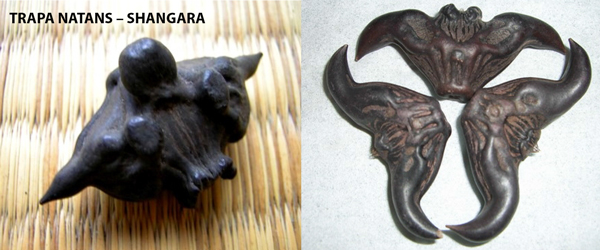 Cultivated in China and India, by at least 3,000 years, this aquatic plant is also known to Tibetans . He arrived in Italy and Europe from ‘ Asia in medieval times, grows wild in marshy areas . From the distant past is also known for its food use ; were recently found fossils of its fruits already known and used as food by the men of the Neolithic. In the summer, each flower becomes a fruit that has a single large seed and fleshy , its wooden body contains starch. The Latin name ” Trapa Natans ” refers to a device of iron spiked with four fronts that ancient Roman soldiers tossed in the paths of the horses to injure their feet. Known in India by the name of Sanghara , this plant has pharmacological properties , is widely used in Ayurvedic medicine . The particular shape of the dried fruits gives it a mysterious appeal to lovers of ‘ occult and magic. In China, its shape and its characteristics are considered auspicious. The bat is a lucky animal , because the name “Bat” ( It was ) just sounds like the word for ” happiness ” ( Fuu ), so the people of China know the trapa natans as Ling Nut , and is considered a lucky food to eat .
Cultivated in China and India, by at least 3,000 years, this aquatic plant is also known to Tibetans . He arrived in Italy and Europe from ‘ Asia in medieval times, grows wild in marshy areas . From the distant past is also known for its food use ; were recently found fossils of its fruits already known and used as food by the men of the Neolithic. In the summer, each flower becomes a fruit that has a single large seed and fleshy , its wooden body contains starch. The Latin name ” Trapa Natans ” refers to a device of iron spiked with four fronts that ancient Roman soldiers tossed in the paths of the horses to injure their feet. Known in India by the name of Sanghara , this plant has pharmacological properties , is widely used in Ayurvedic medicine . The particular shape of the dried fruits gives it a mysterious appeal to lovers of ‘ occult and magic. In China, its shape and its characteristics are considered auspicious. The bat is a lucky animal , because the name “Bat” ( It was ) just sounds like the word for ” happiness ” ( Fuu ), so the people of China know the trapa natans as Ling Nut , and is considered a lucky food to eat .
Used as an amulet bracelets and pendants , Europe and Asia are some rare mala ( rosary) of prayer made with this particular water chestnut .
Due to its odd shape , in the Old Continent have given him a sacred use as a spiritual offering . And ‘ possible to find this rarity of the plant world on the altars of some strange gods . Although this plant is not native to Africa , Europe or South America, can be traced in the rituals of shamans and healers dedicated to animist or pagan cults as Eshu – Ellegua – Legba of West Africa, in the countries of Hades -Pluto ‘ ancient Mediterranean and in religious ceremonies in Guatemala, Nepal , India. Found good results in the treatment against frequent fevers , bronchitis , asthenia , dyspepsia , which is usually used as a revitalizing tonic for the body. Depending on the way you look at it , this oddity botany, carved of course, looks like a diabolical figure , two-horned goat , a bat in flight ! The illusion of a face evil appears on both sides of the pod and the two faces are usually very different . You are looking with trepidation by the Tibetans in the lakes of the north-eastern Tibet Qingai , there are of three kinds: Trapa Bicornis , and Trapa Trapa Natans Engraved . It blooms once a ‘ year and can be found in the fields and arenas , especially maritime , Italy and the Mediterranean islands , widespread in southern Europe, western Asia to the forest areas of the ‘ Himalayas. Present in North Africa and naturalized in the Americas, The seed amulet Trapa Natans is even in Australia.




Recent Comments